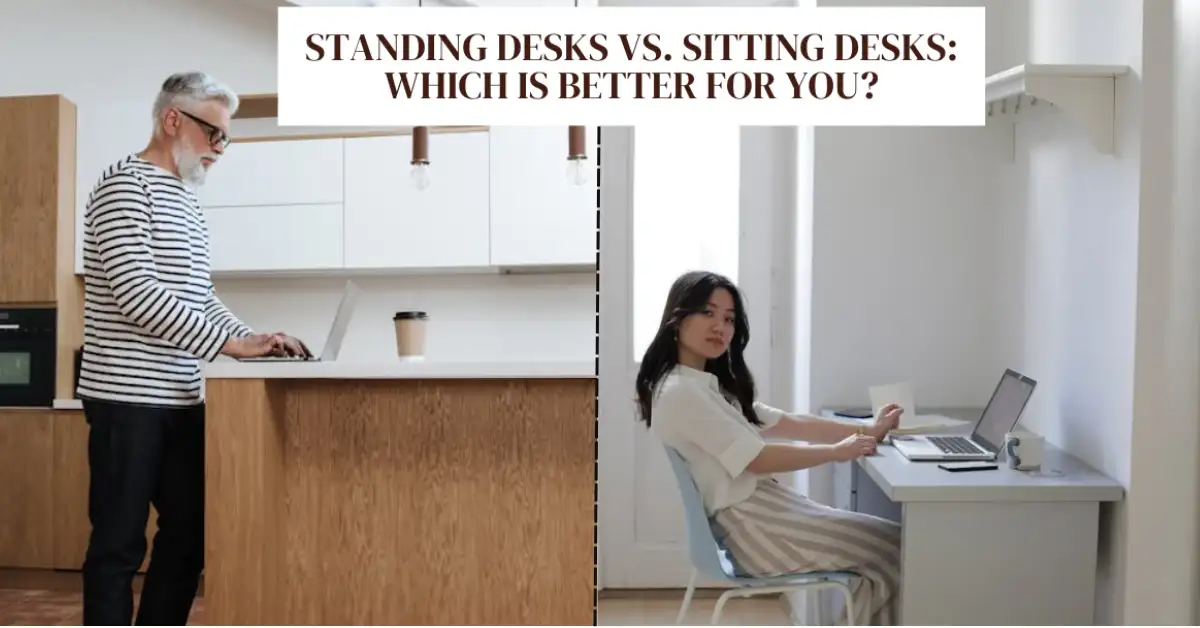Standing Desks vs. Sitting Desks: Which is Better for You?

Standing Desks vs. Sitting Desks: Which is Better for You?
Ever sit restlessly in a chair, wishing you could stand while working? Standing desks have surged in popularity, promising posture perks and more energy. But are they truly better than sitting desks?
Below, we break down pros, cons, and considerations, mentioning Suren Space if you want hammered-metal or reclaimed combos for a stylish workspace. By exploring both desk types, you’ll see which aligns with your health goals, comfort, and daily tasks.
The Case for Sitting Desks
Sitting remains the norm, most people have used traditional desks for decades.
They’re cost-effective, widely available, and pair well with standard office chairs.
Benefits:
- Comfortable Posture: With a well-adjusted chair (seat height, lumbar support), longer sitting can be manageable.
- Lower Fatigue: Standing for hours strains legs, so sitting reduces lower-body fatigue.
- Concentration: Some find focus easier when seated, especially during detailed or lengthy writing tasks.
However, extended sitting can lead to slouching, back pain, or stiffness. Modern workplaces encourage breaks or short walks to counter the downsides of sitting.
If you choose hammered-metal frames from Suren Space for your desk aesthetic, a sitting design can still exude an industrial-luxe vibe, just pair it with comfy, adjustable restaurant chairs India.
The Rise of Standing Desks
Standing desks claim to offset the health risks of prolonged sitting, like obesity, heart issues, or posture woes. By shifting tasks to a standing position, you might gain:
- Better Posture: Standing often encourages a straighter spine.
- Increased Movement: Slight swaying or shifting burns more calories than static sitting.
- Energy & Focus: Many report feeling more alert, countering post-lunch drowsiness.
But it’s not flawless:
- Leg/Foot Strain: Standing too long can tire legs or swell ankles.
- Desk Height Adjustments: Proper elbow and monitor levels require measuring, often ~40–42 inches high.
- Cost: Electric or adjustable standing desks can be pricier than standard ones.
Suren Space may craft hammered-metal frames for a standing desk, blending raw industrial-luxe with ergonomic design. Yes, shipping or custom specs matter, but the final hammered-metal piece can overshadow typical sterile desks.
Combining Both with Adjustable Desks
For many, a sit-stand solution merges the best of each approach:
- Sit-Stand Desks: Shift from ~28–30 inches (sitting) to ~40–42 inches (standing).
- Shared Workstation: Some offices have a standing desk in a communal area for staff to rotate.
- Health & Variety: Changing posture avoids static muscle strain.
When hammered-metal or reclaimed frames from Suren Space factor into an adjustable design, you get both style and posture flexibility. Though cost might rise, the synergy suits modern work environments that value well-being.
Practical Tips for Standing Desk Users
If you opt for a standing desk, mind these pointers:
- Proper Shoe Support: Comfortable footwear or an anti-fatigue mat cushions feet.
- Monitor at Eye Level: Keep the screen so your neck remains neutral, about arm’s length away.
- Alternate: Maybe 30 minutes standing, 30 sitting, listening to body cues.
- Desk Height: Elbows at ~90 degrees, allowing forearms to rest easily.
Which is Better?
Answer: It depends on your body, tasks, and preferences.
- Long tasks or intense focus might favor a sitting desk for stability.
- Short tasks or phone calls might benefit from a standing desk’s energy boost.
- Combined Approach ensures posture variety, possibly offering the best of both worlds.
Suren Space hammered-metal frames can craft either approach, sitting or standing, if industrial-luxe synergy suits your brand or personal style.
Cost and Setup
Sitting Desk:
- Typically cheaper; well-paired with a standard ergonomic restaurant chair table set.
- Easy to find matching designs, wood, laminate, or hammered-metal if you prefer a raw-luxe vibe from Suren Space.
Standing Desk:
- May be pricier, especially if adjustable or motorized.
- Setup needs measuring your ideal elbow and monitor height.
- Comfort essentials like cushioned mats or supportive footwear help offset leg fatigue.
Ergonomics and Health Outlook
- Prolonged Sitting: Risks include slouching, back pain, or metabolic issues.
- Prolonged Standing: Possible foot pain or varicose veins if you stand incorrectly or lack supportive surfaces.
- Balancing both encourages moderate movement, micro-breaks, or short walks, ideal for overall health.
- In some open-plan offices, staff can rotate between dedicated standing desks and normal desks.
Conclusion
Standing Desks vs. Sitting Desks isn’t a clear-cut battleHeach offers distinct perks and drawbacks. Sitting remains a comfortable default, especially for longer tasks, while standing counters sedentary risks, raising energy for short bursts. A hybrid or sit-stand solution merges convenience with health, letting you shift positions throughout the day.
If hammered-metal or reclaimed combos from Suren Space intrigue you, they might craft a custom desk, sitting or standing, that merges industrial-luxe aesthetics with ergonomic function. Ultimately, pick a desk aligning with your work routine, comfort, and brand flair, ensuring each work session fosters productivity and well-being.
READ MORE :: Top 10 Wholesale Furniture Stores/Shops in Chennai, Tamil Nadu

